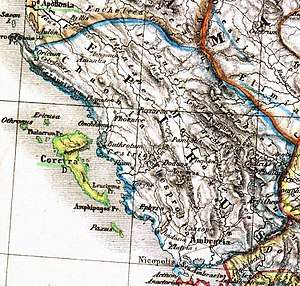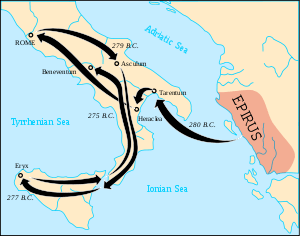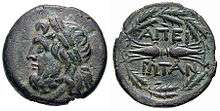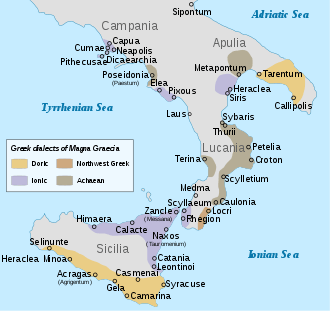Epirus (ancient state)
Epirus (/ɪˈpaɪrəs/; Northwest Greek: Ἄπειρος, Ápeiros; Attic: Ἤπειρος, Ḗpeiros) was an ancient Greek state, located in the geographical region of Epirus in the western Balkans. The homeland of the ancient Epirotes was bordered by the Aetolian League to the south, Thessaly and Macedonia to the east, and Illyrian tribes to the north. For a brief period (280–275 BC), the Epirote king Pyrrhus managed to make Epirus a powerful state in the Greek world, comparable to the likes of Macedon and Rome. His armies marched against Rome during an unsuccessful campaign in Italy.
Epirus Ἄπειρος Ápeiros | |||||||||||||
|---|---|---|---|---|---|---|---|---|---|---|---|---|---|
| 330 BC–167 BC | |||||||||||||
 | |||||||||||||
| Capital | Passaron (330–295 BC) Ambracia (295–224 BC) Phoenice (224–167 BC) | ||||||||||||
| Common languages | Northwest Greek | ||||||||||||
| Religion | Ancient Greek religion | ||||||||||||
| Government | Monarchy (330–231 BC Federal Republic (231–167 BC) | ||||||||||||
| King | |||||||||||||
• 330–313 BC | Aeacides | ||||||||||||
• 307–302 BC | Pyrrhus of Epirus | ||||||||||||
• 302–297 BC | Neoptolemos II | ||||||||||||
• 297–272 BC | Pyrrhus of Epirus | ||||||||||||
• 231–167 BC | Epirote League | ||||||||||||
| Historical era | Classical antiquity | ||||||||||||
• Epirote tribes established united political entity | 330 BC | ||||||||||||
| 280–275 BC | |||||||||||||
• Monarchy abolished | 231 BC | ||||||||||||
| 167 BC | |||||||||||||
| Currency | Epirote drachma | ||||||||||||
| |||||||||||||
History
Prehistory
Epirus has been occupied since at least Neolithic times by seafarers along the coast and by hunters and shepherds in the interior who brought with them the Greek language.[1] These people buried their leaders in large tumuli containing shaft graves, similar to the Mycenaean tombs, indicating an ancestral link between Epirus and the Mycenaean civilization.[1] A number of Mycenaean remains have been found in Epirus,[2][3] especially at the most important ancient religious sites in the region, the Necromanteion (Oracle of the Dead) on the Acheron river, and the Oracle of Zeus at Dodona.[1][4] Epirus had strong links to other Greek regions such as Macedonia, Thessaly, Aetolia and Acarnania.[5]
The Dorians invaded Greece from Epirus and Macedonia at the end of the 2nd millennium BC (circa 1100–1000 BC), though the reasons for their migration are obscure. The region's original inhabitants were driven southward into the Greek mainland by the invasion and by the early 1st millennium BC three principal clusters of Greek-speaking tribes emerged in Epirus. According to Nicholas Hammond (1982) argues that these were the Chaonians of northwestern Epirus, the Molossians in the center, and the Thesprotians in the south.[6] The region inhabited by each of these ethne had its own name (Chaonia, Molossia, Thesprotia), thus there was no single name for the entire region originally.
The Greek toponym Epirus (Greek: Ήπειρος), meaning "mainland" or "continent", first appears in the work of Hecataeus of Miletus in the 6th century BC and is one of the few Greek names from the view of an external observer with a maritime-geographical perspective. Although not originally a native Epirote name, it later came to be adopted by the inhabitants of the area.[7]
Molossian expansion (470–330 BC)
The Molossian Aeacidae dynasty managed to create the first centralized state in Epirus from about 370 BC onwards, expanding their power at the expense of rival tribes. The Aeacids allied themselves with the increasingly powerful kingdom of Macedon, in part against the common threat of Illyrian raids,[8] and in 359 BC the Molossian princess Olympias, niece of Arybbas of Epirus, married King Philip II of Macedon (r. 359–336 BC). She was to become the mother of Alexander the Great. On the death of Arybbas, Alexander the Molossian, uncle of Alexander the Great of Macedon, succeeded to the throne with the title King of Epirus.[9]
In 334 BC, the time Alexander the Great crossed into Asia, Alexander I the Molossian led an expedition in southern Italy in support of the Greek cities of Magna Graecia against the nearby Italian tribes and the emerging Roman Republic. After some successes on the battlefield, he was defeated by a coalition of Italic tribes at the Battle of Pandosia in 331 BC.
Kingdom of Epirus (330–231 BC)

In 330 BC, upon Alexander the Molossian's death, the term "Epirus" appears as a single political unit in the ancient Greek records for the first time, under the leadership of the Molossian dynasty. Subsequently, the coinages of the three major Epirote tribal groups came to an end, and a new coinage was issued with the legend Epirotes.[10] After Alexander's I death, Aeacides of Epirus, who succeeded him, espoused the cause of Olympias against Cassander, but was dethroned in 313 BC.
Aeacides's son Pyrrhus came to the throne in 295 BC. Pyrrhus, being a skillful general, was encouraged to aid the Greeks of Tarentum and decided to initiate a major offensive in the Italian peninsula and Sicily. Due to its superior martial abilities, the Epirote army defeated the Romans in the Battle of Heraclea (280 BC). Subsequently, Pyrrhus's forces nearly reached the outskirts of Rome, but had to retreat to avoid an unequal conflict with a more numerous Roman army. The following year, Pyrrhus invaded Apulia (279 BC) and the two armies met in the Battle of Asculum where the Epirotes won the eponymous Pyrrhic victory, at a high cost.[11]
In 277 BC, Pyrrhus captured the Carthaginian fortress in Eryx, Sicily. This prompted the rest of the Carthaginian-controlled cities to defect to Pyrrhus. Meanwhile, he had begun to display despotic behavior towards the Sicilian Greeks and soon Sicilian opinion became inflamed against him. Though he defeated the Carthaginians in battle, he was forced to abandon Sicily.[12]
Pyrrhus's Italian campaign came to an end following the inconclusive Battle of Beneventum (275 BC). Having lost the vast majority of his army, he decided to return to Epirus, which finally resulted in the loss of all his Italian holdings. Because of his costly victories, the term "Pyrrhic victory" is often used for a victory with devastating cost to the victor.[13]
Epirote League (231–167 BC)

In 233 BC, the last surviving member of the Aeacid royal house, Deidamia, was murdered. Her death brought the Epirote royal family to an abrupt extinction and a federal republic was set up, though with diminished territory, since western Acarnania had asserted its independence, and the Aetolians seized Ambracia, Amphilochia, and the remaining land north of the Ambracian Gulf. The new Epirote capital was therefore established at Phoenice, the political center of the Chaonians. The reasons for the swift fall of the Aeacid dynasty were probably complex. Aetolian pressure must have played a part, and the alliance with Macedonia may have been unpopular; in addition, there were perhaps social tensions.[14] However, Epirus remained a substantial power, unified under the auspices of the Epirote League as a federal state with its own parliament (or synedrion).[14]
In the following years, Epirus faced the growing threat of the expansionist Roman Republic, which fought a series of wars with Macedonia. The League remained neutral in the first two Macedonian Wars but split in the Third Macedonian War (171–168 BC), with the Molossians siding with the Macedonians and the Chaonians and Thesprotians siding with Rome. The outcome was disastrous for Epirus; Molossia fell to Rome in 167 BC and 150,000 of its inhabitants were enslaved.[1]
Organization
.jpg)
In antiquity, Epirus was settled by the same nomadic Hellenic tribes that went on to settle the rest of Greece.[15] Unlike most other Greeks of the time, who lived in or around city-states such as Athens or Sparta, the Epirotes lived in small villages and their way of life was foreign to that of polis of southern Greeks. Their region lay on the edge of the Greek world and was far from peaceful; for many centuries, it remained a frontier area contested with the Illyrian peoples of the Adriatic coast and interior. However, Epirus had a far greater religious significance than might have been expected given its geographical remoteness, due to the presence of the shrine and oracle at Dodona – regarded as second only to the more famous oracle at Delphi.[16]
Culture
At least since classical antiquity, the Epirotes were speakers of an epichoric Northwest Greek dialect, different from the Dorian of the Greek colonies on the Ionian islands, and bearers of mostly Greek names, as evidenced by epigraphy.[17]
Nicholas Hammond argues that the principal social structure of the Epirotes was the tribe and that they spoke a West-Greek dialect.[18] Tom Winnifrith (1983) argues that the Epirotes became culturally more closely connected to the rest of the Greek world during the centuries that preceded the Roman conquest of the region (3th-2nd century BC), while hellenisation process continued even after the conquest. As such their rulers claimed Greek descent.[19] On the other hand Johannes Engels (2010), argues that genealogical links through the Trojan cycle and other myths strongly connected Epirus with the rest of Greece, precluding serious debate about the Greekness of the Epirotes. The language they spoke was regarded as a primitive Northwestern Greek dialect, but there was no question that it was Greek. The way of life in Epirus was more archaic than that in the Corinthian and Corcyrean colonies on the coast, but there was never a discussion about their Greekness.[20]
The Epirotes seem to have been regarded with some disdain by some ancient Greek writers in classical antiquity. The 5th century BC Athenian historian Thucydides describes them as "barbarians" in his History of the Peloponnesian War,[21] as does Strabo in his Geography.[22] Other writers, such as Dionysius of Halicarnassus,[23] Pausanias,[24] and Eutropius,[25] describe them as Greeks. Simon Hornblower interprets the vague, and sometimes even antithetical, comments of Thucydides on the Epirotes as implying that they were neither completely "barbarian" nor completely Greek, but akin to the latter. Notably, Thucydides had similar views of the neighboring Aetolians and Acarnians, even though the evidence leaves no doubt that they were Greek. The term "barbarian" may have denoted not only clearly non-Greek populations, but also Greek populations on the fringe of the Greek world with peculiar dialects.[26] A far more reliable source on the views of the Greeks is the list of sacred envoys (Ancient Greek: θεαρόδοκοι) in Epidaurus, which includes the Epirotes.[27] The list which was compiled in 360 BC includes the sacred envoys (members of the ruling family of each tribe or subtribe) of the Molossians, Kassopeans, Chaonians and Thesprotians.[28]
In terms of religion they worshipped the same gods like the rest of the Greeks. No traces of non-Greek deities were found until the Hellenistic age (with the introduction of oriental deities in the Greek world). Their supreme deity was Zeus and the Oracle of Dodona found in the land of the Molossians attracted pilgrims from all over the Greek world. As with the rest of the Epirotes they were included in the thearodokoi catalogues where only Greeks were allowed in order to participated in Panhellenic Games and festivals.[29] Aristotle considered the region around Dodona to have been part of Hellas and the region where the Hellenes originated.[30]Plutarch mentions an interesting cultural element of the Epirotes regarding the Greek hero Achilles. In his biography of King Pyrrhus, he states that Achilles "had a divine status in Epirus and in the local dialect he was called Aspetos" (meaning "unspeakable" or "unspeakably great" in Homeric Greek).[31][32]
References
Citations
- "Epirus". Encyclopædia Britannica. Encyclopædia Britannica, Inc. Retrieved 16 November 2013.
- Tandy 2001, p. 4
- McHenry 2003, p. 527: "Epirus itself remained culturally backward during this time, but Mycenean remains have been found at two religious shrines of great antiquity in the region: the Oracle of the Dead on the Acheron River, familiar to the heroes of Homer's Odyssey."
- Tandy 2001, pp. 23, 30.
- Filos 2018, p. 215.
- Hammond 1982, p. 284.
- Douzougli, Angelika; Papadopoulos, John (2010). "Liatovouni: a Molossian cemetery and settlement in Epirus". Jahrbuch des Deutschen Archäologischen Instituts. 125: 3.
- Anson 2010, p. 5.
- Hammond 1994, p. 438.
- Hammond 1994, p. 442.
- Franke 1989, pp. 462–479.
- Franke 1989, pp. 477–480.
- Franke 1989, p. 468.
- Walbank 1984, p. 452.
- Borza 1992, p. 62; Minahan 2002, p. 578.
- Hammond 1967.
- Katičić 1976, pp. 123–124; Filos 2018, pp. 233–234.
- Hammond 1998: "Epirus was a land of milk and animal products [...] The social unit was a small tribe, consisting of several nomadic or semi-nomadic groups, and these tribes, of which more than seventy names are known, coalesced into large tribal coalitions, three in number: Thesprotians, Molossians and Chaonians [...] We know from the discovery of inscriptions that these tribes were speaking the Greek language (in a West-Greek dialect)."
- Winnifrith, Tom (1983). Greeks and Romans. Springer. p. 73. ISBN 1349051233.
- Joseph Roisman; Ian Worthington (7 July 2011). A Companion to Ancient Macedonia. John Wiley & Sons. p. 83-84. ISBN 978-1-4443-5163-7.
- Thucydides. The History of the Peloponnesian War, 1.8.
- Strabo. Geography, 7.7.1.
- Dionysius of Halicarnassus. Roman Antiquities, 20.10 (19.11).
- Pausanias. Description of Greece, 1.11.7–1.12.2.
- Eutropius. Abridgment of Roman History (Historiae Romanae Breviarium), 2.11.13.
- Filos 2018, p. 218.
- Filos 2018, p. 219.
- Davies, J. K. (2002). "A Wholly Non-Aristotelian Universe: The Molossians as Ethnos, State, and Monarchy". In Roger Brock (ed.). Alternatives to Athens: Varieties of Political Organization and Community in Ancient Greece. Oxford University Press. p. 247. ISBN 0199258104.
- Hatzopoulos, M. B.; Sakellariou, M.; Loukopoulou, L. D. (1997). Epirus, Four Thousand Years of Greek History and Civilization. Ekdotike Athenon. p. 140-141. ISBN 960-213-377-5.
It is equally incostestable that the Epirote tribes proctised the same religion as the other Greeks. The supreme god of the Epirotes was Zeus and his sanctuary at Dodona attracted believers from all over the Greek world. Foreign deities are not attested...The most convicing proof, however, that the Epirotes belonged firmly within the religious body of Greece, is provided by the catalogue of thearodokoi listing Greek cities and tribes to which the major hellenic sanctuaries sent theoroi to... only Greeks were allowed to, participate in the pan-hellenic games and festivals
CS1 maint: ref=harv (link) - Hammond 1986, p. 77: "The original home of the Hellenes was 'Hellas', the area round Dodona in Epirus, according to Aristotle. In the Iliad it was the home of Achilles' Hellenes."
- Plutarch. Parallel Lives: Pyrrhus, 1.
- Cameron 2004, p. 141: "As for Aspetos, Achilles was honored at Epirus under that name, and the patronymic [Ἀ]σπετίδης is found in a fragmentary poem found on papyrus."
Sources
- Anson, Edward M. (2010). "Why Study Ancient Macedonia and What This Companion is About". In Roisman, Joseph; Worthington, Ian (eds.). A Companion to Ancient Macedonia. Oxford, Chichester, & Malden: Wiley-Blackwell. pp. 3–20. ISBN 978-1-4051-7936-2.CS1 maint: ref=harv (link)
- Antoniadis, Vyron (2016). Tabula Imperii Romani: J 34 - Athens: Epirus. Athens: Academy of Athens. ISBN 978-960-404-308-8.
- Borza, Eugene N. (1992). In the Shadow of Olympus: The Emergence of Macedon. Princeton, NJ: Princeton University Press. ISBN 0-691-00880-9.CS1 maint: ref=harv (link)
- Cameron, Alan (2004). Greek Mythography in the Roman World. New York and Oxford: Oxford University Press. ISBN 0-19-517121-7.CS1 maint: ref=harv (link)
- Filos, Panagiotis (2018). "The Dialectal Variety of Epirus". In Giannakis, Georgios K.; Crespo, Emilio; Filos, Panagiotis (eds.). Studies in Ancient Greek Dialects: From Central Greece to the Black Sea. Berlin and Boston: Walter de Gruyter. pp. 215–248. ISBN 978-3-11-053213-5.CS1 maint: ref=harv (link)
- Franke, P. R. (1989). "CHAPTER 10 PYRRHUS". In Astin, A. E.; Walbank, F. W.; Frederiksen, M. W.; Ogilvie, R. M.; Drummond, A. (eds.). The Cambridge Ancient History: The Rise of Rome to 220 BC. VII, Part 2. Cambridge: Cambridge University Press. pp. 456–485. ISBN 0-521-23446-8.CS1 maint: ref=harv (link)
- Hammond, Nicholas Geoffrey Lemprière (1998). Philip of Macedon. London: Duckworth. ISBN 0-7156-2829-1.CS1 maint: ref=harv (link)
- Hammond, Nicholas Geoffrey Lemprière (1994). "CHAPTER 9d. ILLYRIANS AND NORTH-WEST GREEKS". In Lewis, David Malcolm; Boardman, John; Hornblower, Simon; Ostwald, M. (eds.). The Cambridge Ancient History: The Fourth Century B.C. VI (2nd ed.). Cambridge: Cambridge University Press. pp. 422–443. ISBN 0-521-23348-8.CS1 maint: ref=harv (link)
- Hammond, Nicholas Geoffrey Lemprière (1982). "CHAPTER 40 ILLYRIS, EPIRUS AND MACEDONIA". In Boardman, John; Hammond, Nicholas Geoffrey Lemprière (eds.). The Cambridge Ancient History: The Expansion of the Greek World, Eighth to Sixth Centuries B.C. III, Part 3 (2nd ed.). Cambridge: Cambridge University Press. pp. 261–285. ISBN 0-521-23447-6.CS1 maint: ref=harv (link)
- Hammond, Nicholas Geoffrey Lemprière (1967). Epirus: The Geography, the Ancient Remains, the History and the Topography of Epirus and Adjacent Areas. Oxford: The Clarendon Press.CS1 maint: ref=harv (link)
- Katičić, Radoslav (1976). Ancient Languages of the Balkans. The Hague: Mouton. ISBN 978-9-02-793305-8.CS1 maint: ref=harv (link)
- McHenry, Robert (2003). The New Encyclopædia Britannica (15th ed.). Chicago, IL: Encyclopædia Britannica, Inc. ISBN 978-0-85-229961-6.CS1 maint: ref=harv (link)
- Minahan, James (2002). Encyclopedia of the Stateless Nations: Ethnic and National Groups around the World. Westport, CT: Greenwood Press. ISBN 0-313-31617-1.CS1 maint: ref=harv (link)
- Tandy, David W. (2001). Prehistory and History: Ethnicity, Class and Political Economy. Montréal, Québec, Canada: Black Rose Books Limited. ISBN 1-55164-188-7.CS1 maint: ref=harv (link)
- Walbank, Frank William (1984) [1928]. "CHAPTER 12 MACEDONIA AND THE GREEK LEAGUES". In Walbank, F. W.; Astin, A. E.; Frederiksen, M. W.; Ogilvie, R. M. (eds.). The Cambridge Ancient History: The Hellenistic World. VII, Part 1. Cambridge: Cambridge University Press. pp. 446–481. ISBN 978-0-521-23445-0.CS1 maint: ref=harv (link)
